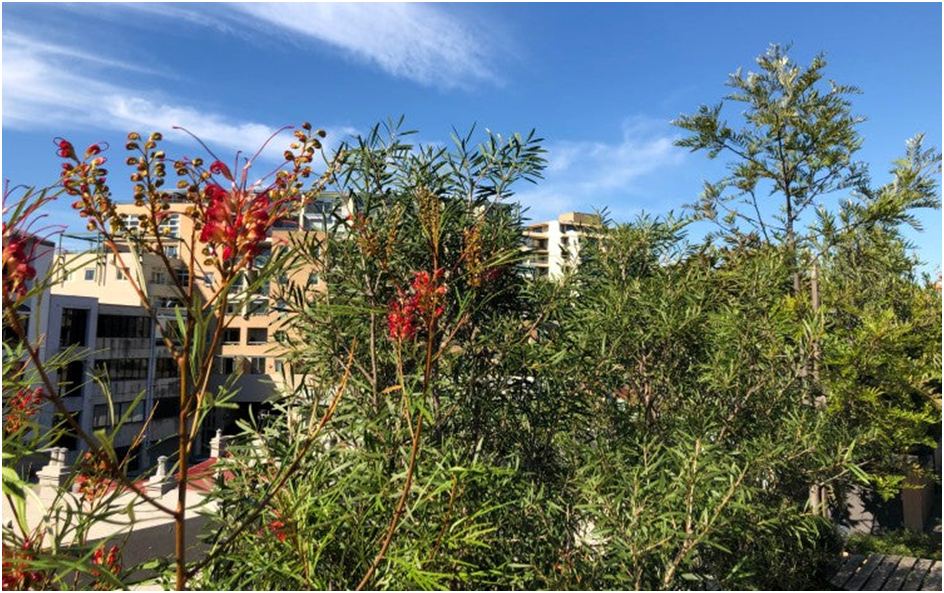The Garden Rooftop
Having a balcony garden can dramatically change the way your living space feels. Coming home can be like stepping into your own private oasis. Your balcony or terrace can also become a productive ecosystem that can activate an otherwise barren and lifeless urbanscape with birds, bees and butterflies. Here are some tips on how to unlock the potential of your balcony, no matter what the size or orientation.
Understand the climate of your balcony
Before you start spending money on pots, potting mix and plants, check the conditions and natural climate of your balcony.
Check the hours of sun and shade your balcony receives. Also, check whether it will receive any wind or rain or if it will be completely shielded. The conditions of your balcony dictate the type of plants that will thrive.

It also makes shopping at the nursery a lot more cost-effective as it will help to guide what questions to ask the horticulturalists that work there, and they’ll help make your plant selection informed and productive.
Lots of wind
- Avoid buying tall, narrow or cone-shaped pots. Try to find cylindrical or square pots that won’t get too top-heavy and fall over with a big gust. We found this out the hard way!
- Constant wind will dry out your pots faster than anything else, so they will need more water in these conditions.
- We’ve found that bracing our trees to the balcony balustrade, or bracing the trunk with stakes, is the best way to keep trees from snapping in the wind.
Lots of shade
- When you go to the nursery you can shop in the indoor section for leafy plants that grow on the ground in rainforests, like orchids.
- Make sure you use a good quality free-draining potting mix so that your pots and balcony don’t stay too moist.
Shade and protection are great for getting into propagating and cuttings. You could even create your own micro-nursery! Lots of sun
Lots of sun
-
- You have a lot of options and it really depends on your watering system and hand-watering frequency.
- Succulents are a great option if you won’t be able to water at least once every two days. Pots dry out very quickly in the sun.
Apply mulch to the top layer of your pots after watering. This will retain soil temperature and keep moisture in, so the soil doesn’t completely dry out after a hot day
 Now that you have a good idea of the climate and potential of your garden, you can start getting excited about making your garden oasis!Collect different sized pots to add variety and depthFinding pots can be an expensive exercise. After collecting over 150 pots that fill our own 200-square-metre balcony, we know a thing or two about the pains of collecting pots
Now that you have a good idea of the climate and potential of your garden, you can start getting excited about making your garden oasis!Collect different sized pots to add variety and depthFinding pots can be an expensive exercise. After collecting over 150 pots that fill our own 200-square-metre balcony, we know a thing or two about the pains of collecting pots
 Sometimes it’s not worth being too fussy about the look of the pot. Good pots are also hard to find. Start to build your garden up by collecting whatever you can get your hands on.
Sometimes it’s not worth being too fussy about the look of the pot. Good pots are also hard to find. Start to build your garden up by collecting whatever you can get your hands on.
Getting a mix of shabby, new, second-hand, or repurposed pots can actually make your garden look more interesting.
- Have a look around council collection time – someone’s trash can be someone else’s ideal pot!
- Once your plants are established, the pots will become secondary anyway, and the variety will add to the overall look and feel of a biodiverse and healthy garden.
- Collecting different sized pots also forces you to buy different sizes and types of plants, which can make your potted garden feel like a little garden of Eden.
 We upsize pots when a plant has outgrown it, so our plants are always moving around and receiving care.Vary the types of plants you getCreate a feast for your eyes when you look out at your balcony by collecting plants of different sizes and leaf and flower types. Tier your garden with a combination of small flowers, cascading creepers and upright bushes to add depth of focus.
We upsize pots when a plant has outgrown it, so our plants are always moving around and receiving care.Vary the types of plants you getCreate a feast for your eyes when you look out at your balcony by collecting plants of different sizes and leaf and flower types. Tier your garden with a combination of small flowers, cascading creepers and upright bushes to add depth of focus.
Prostrate plants
Flowering creepers or shrubs that grow naturally in rockeries can provide a lovely cascading effect as they droop over pots.
Bird and bug attracting bushes
Always look out for plants that attract birds and bees. You’d be surprised at how a single bush can bring your garden to life. We highly recommend natives such as grevilleas as they are hard to beat for attracting native wildlife and insects.
Trees
Being in a pot, trees are unlikely to grow too big for the space. They will grow until their roots fill the pot and then remain stunted, which keeps them manageable. A good prune every now and then will also help maintain the right shape.
Herbs, salads and veggies
There are many products on the market that make growing food on a balcony much easier.

We have two large beds to grow vegetables and herbs, they come in all sizes.
 A grevillea “Wendy Sunshine” cascades out of its pot, while a “Bronze Rambler” gives the effect of ground cover in a low pot.
A grevillea “Wendy Sunshine” cascades out of its pot, while a “Bronze Rambler” gives the effect of ground cover in a low pot.
Keep the soil healthy
Drainage
Gardening in pots has its benefits. One of the big benefits is being able to design the drainage yourself using pebbles, styrofoam or plastic drainage cells (which is what we use for big pots, covered by a layer of geofabric and 30mm layer of coarse river sand). If you don’t set up the drainage in your pot right first then your plants could really suffer later on.
Potting mix
Start off on the right foot by buying a premium potting mix. If you’re planting natives make sure you’re using a native potting mix, as a lot of plants can be very sensitive to soil composition.
Plant feed
- Seaweed solution every few weeks
- Slow-release fertiliser every six months as new growth is forming
- Diluted worm wee – whenever you remember
- Compost mixture – for a nutrient-rich soil top-up
- Mulch – protect the topsoil from drying out and to regulate the soil temperature
- You might think that having a worm farm or compost bin could attract pests, but the types of life that assist the decomposition process all pretty much stay inside the tubs. So you can have a very tidy balcony with a worm farm tucked away in the corner. If you have the balance of brown (dried leaves and cardboard) and green (veggie scraps and fresh leaves) just right it won’t smell at all
Go native!
Something that has brought us a lot of joy on our balcony is our attempts to grow as many native Australian plants as possible. Like with anything new, it has been a learning curve, and definitely worthwhile as our garden now hosts an array of pollinating wildlife like native blue-banded bees and monarch butterflies.
Even though we live right on the main road, in one of the busiest areas of inner-Sydney, our balcony at least has some resemblance to the natural landscape and has its own thriving ecosystem.
 Bottlebrush
Bottlebrush
Great as a hedge or tree for screening. You’ll be rewarded if you give them lots of water!
Grevillea
Beautiful flowers with many different varieties. They need frequent watering but the birds will love them!
Kangaroo paw
These grow really well in any sized pots, particularly if you’re not located in WA where they grow naturally.
Wattle
Lots of varieties with some very fast-growing options that can thicken up in one season to block out neighbouring buildings.
 Our wall of natives provides screening from nearby tall apartment buildings.
Our wall of natives provides screening from nearby tall apartment buildings.
Patience and perseverance
People always say so to me: ‘I couldn’t even keep a tiny succulent alive on my balcony, so I gave up.’ The lesson to learn here is to try a different type of plant, in a different kind of pot, with a different kind of treatment! It doesn’t mean you can’t have a garden; it just means you have an opportunity to experiment with different ways of gardening.
Lots of plants will die along the way, it’s completely normal. Every gardener makes mistakes and knows the feeling of loving (and neglecting) a plant to death. Amazing gardens aren’t grown in a day, it takes time for your space to feel established and lush.
Follow Ian and Philip on Instagram @thegardenrooftop for more gardening advice
Article originally posted on: https://www.hoselink.com.au/blogs/diy-projects/how-to-create-your-own-balcony-garden


